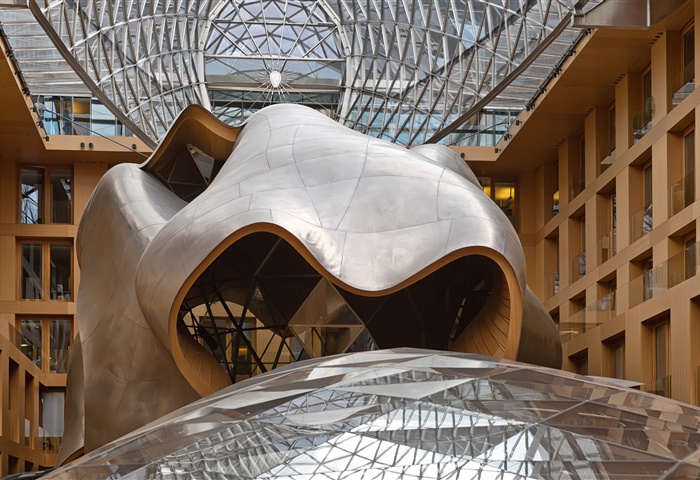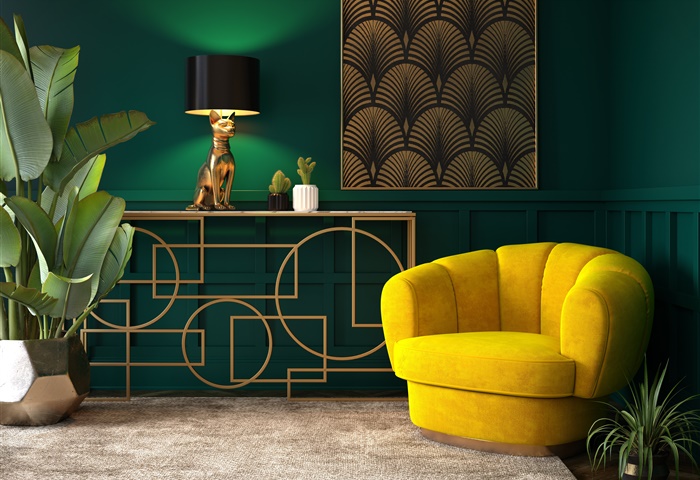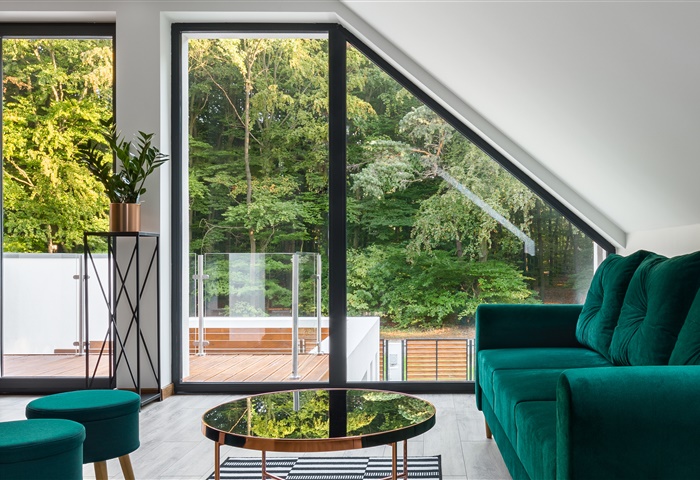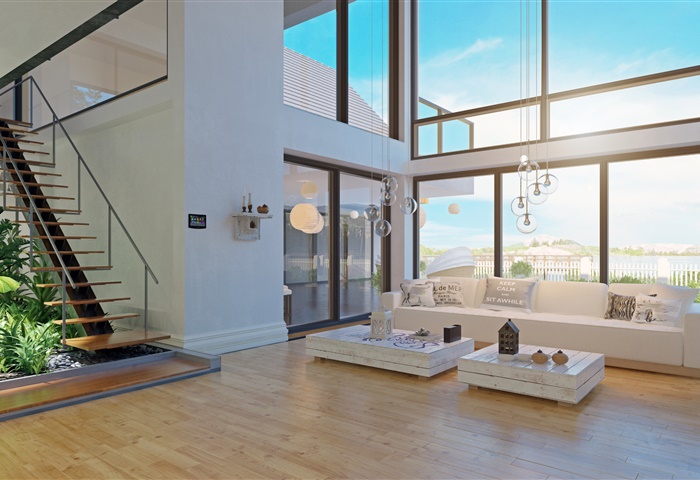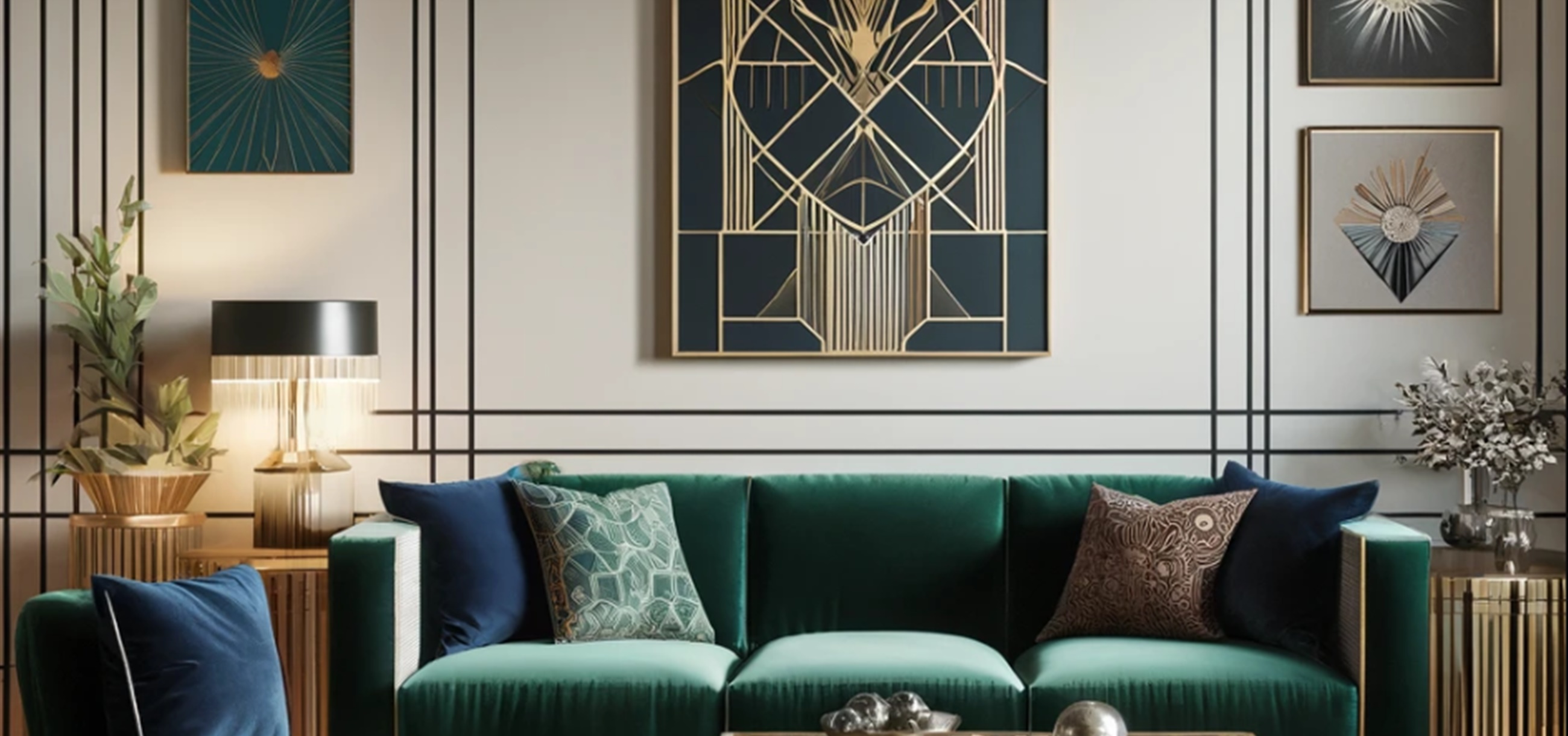
Key Elements of Modern Vintage Interior Design
Vintage style is more than just an assembly of antique pieces; it's a carefully curated presentation of history, story, and personal style. The modern adaptation of vintage interior design does not merely replicate past eras but rather integrates their distinct elements with contemporary trends to create a timeless ambiance. This section delves into the key elements of furniture, color palettes, and decorative accents from significant design eras, along with the modern twists that keep these styles fresh and functional in today's homes.
Furniture: A Blend of Time and Style
1920s Art Deco: Furniture from the 1920s Art Deco period is renowned for its bold geometric shapes and extravagant detail. Think high-gloss lacquered finishes, mirrored surfaces, and metallic accents. Modern adaptations often tone down the opulence but retain the clean lines and glamorous feel. For instance, a contemporary room might feature a streamlined Art Deco-inspired console paired with a modern abstract painting, blending past elegance with modern simplicity.
1950s-1960s Mid-Century Modern: Mid-century modern furniture is perhaps the most enduring and popular among vintage styles today. Its functionality and simplicity allow for seamless integration into contemporary interiors. Iconic pieces like the Eames lounge chair or the Saarinen tulip table are now staples in modern homes, often paired with contemporary materials like tempered glass and modern art to maintain a balance between old and new.
1970s Bohemian: The relaxed and eclectic vibe of the 1970s Bohemian style brings warmth and personality to modern spaces. Rattan furniture, which was hugely popular in the '70s, has seen a resurgence, with pieces like rattan chairs or bed frames serving as focal points in contemporary bedrooms or living rooms. These items are often matched with modern minimalist décor, such as plain white bedding or simple, monochrome cushions, to prevent the space from feeling overly retro.
Color Palettes: Reviving Pastels and Bolds
1940s Streamline Moderne: The color schemes of the 1940s were often subdued due to the war effort, focusing on practical and muted tones. Today, these colors are enhanced and used in modern homes to evoke a sense of calm and simplicity. Soft grays and navy can serve as a backdrop for bolder mid-century furnishings or contemporary art, creating a cohesive look that bridges decades.
1960s Pop Art Influence: The vibrant, contrasting colors typical of the 1960s, influenced by Pop Art, make a bold statement even in small doses. A modern home might feature a pop art-inspired color palette with splashes of bright red, blue, or yellow against a more neutral setting. This can be effectively achieved through accessories like cushions, vases, or a single accent chair, which add a lively touch without overwhelming the space.
1980s Pastels and Neons: The pastels and neons of the 1980s are used more judiciously in contemporary interior designs. Instead of full rooms painted in bright, saturated colors, these hues are now used in accents and artwork that highlight specific areas within a room, bringing an element of fun and nostalgia without the dated feel of the '80s decor.
Decorative Accents: Art, Lighting, and More
Art Deco Lighting: Lighting fixtures from the Art Deco period are works of art in themselves, featuring materials like frosted glass and brass. Modern versions might simplify the ornate designs of the past but keep the geometric shapes and luxurious feel, such as a brass geometric chandelier that acts as a statement piece in a contemporary dining room.
Mid-Century Wall Art: Wall art from the mid-century era, characterized by abstract forms and organic lines, perfectly complements modern minimalist interiors. Today, these pieces are often reinterpreted with a modern twist, using updated colors and materials to fit current trends while still nodding to their mid-century roots.
Rugs and Textiles: Vintage rugs and textiles, particularly those with patterns or techniques specific to a certain era, add texture and depth to modern interiors. A Persian rug can anchor a contemporary living room furnished with modern sofas and coffee tables, providing a link to the past that enhances the overall design narrative.
Incorporating vintage style into modern homes is about striking the right balance between homage and innovation. By understanding the key elements of vintage design and adapting them to contemporary tastes and lifestyles, designers and homeowners can create spaces that are both nostalgic and forward-looking. This approach not only preserves the essence of the past eras but also ensures that the designs remain functional and relevant in today’s living environments. How to Incorporate Vintage Style in Modern Homes
Integrating vintage elements into modern homes requires a thoughtful approach to balance and harmony. Whether it's a full-on vintage revival or subtle nods to the past, the goal is to achieve a cohesive look that respects both the old and the new. Here’s a room-by-room guide on incorporating vintage style into contemporary spaces, along with practical tips to ensure a seamless blend.
Living Room
Combining Furniture: Start with a statement vintage piece, such as a mid-century modern sofa or an ornate Art Deco coffee table, and surround it with modern furnishings to highlight its uniqueness. The contrast between the old and the new can create a dynamic yet harmonious look. For example, a sleek, modern leather sofa can be paired with a vintage wooden coffee table featuring intricate designs. The combination of different textures and eras adds depth and interest to the space.
Decorative Accents: Use vintage lamps, old-school posters, or classic vases as accents. These smaller items can be easily integrated into a modern decor without overwhelming it. A 1960s brass floor lamp beside a contemporary couch or vintage posters framed in modern frames can serve as focal points.
Color and Fabric: To keep the room feeling cohesive, select a color palette that complements both the vintage and modern pieces. Neutral walls can serve as a backdrop that allows both styles to shine without clashing. Incorporating similar fabrics or patterns in both vintage and modern pieces (like velvet cushions on both an old armchair and a new sofa) can also tie the room together.
Bedroom
Vintage Bed Frames: A vintage bed frame, whether it’s a wrought iron frame from the Victorian era or a wooden art deco headboard, can serve as the centerpiece of a modern bedroom. Pair it with crisp, modern bedding and a minimalist nightstand to maintain a clean, updated look.
Artwork and Mirrors: Hang vintage artwork or mirrors to add character. An antique mirror above a modern dresser or vintage oil paintings in contemporary frames can bridge the gap between different periods.
Lighting and Textiles: Soften the room with vintage lighting fixtures and textiles. A 1970s chandelier or mid-century modern lamps on bedside tables can illuminate the space beautifully. Use vintage throw rugs or curtains to add pattern and texture without committing fully to any single era.
Kitchen
Cabinetry and Hardware: In the kitchen, vintage style can be incorporated through cabinetry and hardware. Replace modern cabinet knobs with vintage-style handles to add old-world charm. A mix of open shelving with a few antique pieces can also evoke a vintage feel without sacrificing the functionality of modern design.
Appliances and Accessories: While modern appliances are preferred for functionality, vintage-style appliances (like retro refrigerators or vintage-inspired ovens) can serve as statement pieces. Smaller accessories like vintage canisters or classic scales can add a decorative touch without overwhelming the modern aesthetic.
Tiles and Flooring: Use patterned tiles reminiscent of past eras for backsplashes or flooring. These can dramatically enhance the room's character while keeping the rest of the design modern and subdued.
Bathroom
Fixtures and Fittings: Incorporate vintage fixtures like claw-foot tubs or pedestal sinks to instantly give the bathroom a vintage flair. Modern fixtures with vintage designs can also work if actual antique pieces are too cumbersome or out of budget.
Tiles and Wallpapers: Patterned tiles or wallpapers can add a vintage touch to a modern bathroom. Choose designs that mimic the past but in colors that match the current palette to maintain a modern vibe.
Accessories: Towel racks, soap dispensers, and mirrors in vintage styles can subtly bring in elements from the past. These small changes can make a significant impact without altering the overall contemporary feel of the bathroom.
Tips for Maintaining Balance
Choose a Focal Point: Let one large vintage piece take center stage in each room, and keep other elements more subdued.
Mix Materials and Textures: Combine different materials and textures from various eras to create a layered yet cohesive look.
Consistent Color Scheme: Use a consistent color scheme throughout the home to unify the mix of styles.
Edit and Curate: Avoid overcrowding by carefully selecting which vintage pieces to display. Quality over quantity ensures that each piece stands out and contributes to the overall aesthetic.
By following these guidelines, incorporating vintage style into a modern home can be both stylish and seamless, creating a living space that is both nostalgic and refreshingly contemporary. This approach not only pays homage to historical design but also personalizes and enriches the living environment.
Benefits of Vintage Style in Interiors
Sustainability: One of the most significant advantages of incorporating vintage style into interior design is sustainability. By reusing and repurposing old furniture, not only are you reducing waste, but you're also conserving the resources that would have been used to produce new items. Vintage pieces, often made from high-quality materials and craftsmanship not commonly found in mass-produced modern furniture, can serve for many more years, continuing their lifecycle in stylish and functional ways.
Timelessness: Vintage interior design transcends the fleeting trends that often characterize modern decor. It represents a lasting aesthetic that maintains its charm and appeal over the years. Integrating vintage pieces into a home can create a timeless feel, ensuring that the decor remains stylish and appealing regardless of changing trends. This enduring quality makes vintage style a wise investment for those looking to create a home with a lasting appeal.
Personalization: Vintage style allows for a high degree of personalization in interior design. Each piece tells a story—whether it’s a mid-century lamp found at an estate sale or a vintage rug passed down through generations. These pieces allow homeowners to reflect their personal history, travels, and tastes in a way that new, off-the-shelf items simply cannot. This personal touch adds depth and individuality to the home, making it uniquely yours.
Challenges and Solutions
Finding Authentic Vintage Pieces: One of the challenges of decorating with vintage style is locating authentic pieces that fit your vision. To overcome this, frequent local antique shops, estate sales, and online marketplaces that specialize in vintage goods. Building relationships with antique dealers can also provide you with a source of valuable information and first dibs on new arrivals.
Dealing with Wear and Tear: Vintage items often come with signs of age, which can include wear and tear that may require restoration. Address this by learning basic restoration techniques or working with professionals who specialize in restoring vintage furniture. Choosing pieces that require less intensive repairs can also mitigate this issue, maintaining the charm of the piece while ensuring functionality.
Blending Different Eras Without Clashing: To successfully blend different eras, focus on finding a common element, such as color, material, or design style, that can act as a unifying factor. Use modern pieces sparingly to complement rather than overshadow the vintage elements. This creates a cohesive look that celebrates each piece’s uniqueness without creating visual discord.
Conclusion
The enduring appeal of vintage style in interior design lies in its ability to blend beauty, history, and functionality in a uniquely sustainable fashion. This style provides a canvas for expressing personal history and tastes while offering an eco-friendly approach to decorating. Each vintage piece adds a layer of depth and character to a home, making it not just a living space but a personal statement.
As we continue to navigate a world of ever-changing design trends, the timeless charm and individuality of vintage style remain a constant. Whether through a dramatic Art Deco chandelier or a subtle mid-century vase, vintage decor encourages creativity and personal expression. It invites each of us to tell our stories through our surroundings, to curate spaces that are not only beautiful and functional but also deeply reflective of our journeys and values. Let this guide inspire you to explore the rich tapestry of vintage style and to weave it into your modern home in ways that speak uniquely to you.


